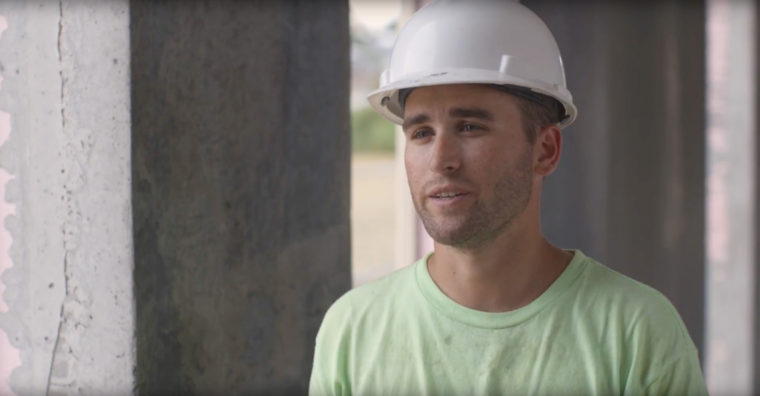Concrete is the most widely used construction material in the world. Billions of tons are produced annually.
But for the 2017 Solar Decathlon, “we wanted to demonstrate a new approach,” said Dylan Weber Callahan, a master’s candidate in both architecture and construction management at Washington University in St. Louis. “We wanted to show that concrete could be used in more sustainable ways.”
Over the last two years, more than 100 students from the Sam Fox School of Design & Visual Arts, the School of Engineering and Applied Science and the International Center for Energy, Environment and Sustainability (InCEES) have worked with industry partners to design, fabricate and now finally construct CRETE House.
The solar-powered, 995-square-foot residence — which currently is being assembled on the university’s North Campus — is built almost entirely from pre-cast concrete. Water coils embedded within the floors and ceiling, rather than a traditional HVAC system, provide heating and cooling. Large gutters foster shade and direct run-off to a hydroponic garden capable of feeding residents for much of the year.
“Concrete is extremely durable, so we have a very resilient house,” said Ethan Miller, likewise a master’s candidate in architecture and construction management. “We also took into account, in the steel connections, seismic forces, so that this house will not only be able to withstand tornados and hurricanes, but also earthquakes.”
Sponsored by the U.S. Department of Energy, the biennial Solar Decathlon challenges university teams from around the world to design and build full-size, energy-efficient houses. This year’s competition will take place Oct. 5-15 in Denver.
Students will spend the next several weeks at North Campus, completing initial assembly and testing and refining systems. In September, they’ll take the house back apart, drive the components to Denver and reassemble the house on site. After the competition, CRETE House will be permanently installed at the university’s Tyson Research Center as a residence for visiting scientists.
“Concrete is typically used on larger commercial projects,” Callahan concluded. Yet the material’s durability, thermal properties and ubiquity could also hold the key to making residential construction more sustainable.
“We wanted to create a catalyst for how concrete might be used more efficiently in the future.”
For more information about Solar Decathlon, visit solardecathlon.wustl.edu or follow Team WashU on Facebook and Twitter.
Faculty advisors
Hongxi Yin, InCEES, Sam Fox School
Pablo Moyano, Sam Fox School
Ryan Abendroth, Sam Fox School
Tim Michels, Energy, Environmental and Chemical Engineering
Chenyang Lu, Engineering & Applied Science
Steve Bannes, construction management
Industry sponsors
Anova
Architectural Design Guild
Ben Hur Construction
BFW Contractors
Blomberg
Bon Appetit
Chicago Contractor’s Supply
Clayco
Continental Cement
Ductal
Dukane Precast Inc.
Eisen Group
EnCon Design
Energy Resources Group
Enterprise Precast Concrete
Filtrexx
Frieze & Associates
Gate Precast
Gibbons Crane Rental
Hard Rock Concrete Cutters
HydroTemp
Icon Mechanical
InXpress
Kohler
LafargeHolcim
Lombard Architectural Precast Products Company
McMillan Cabinetmakers
Metro Lighting
Nawkaw
PCI Precast/Prestressed Concrete Institute
PCI Foundation
Peak Building Products, LLC
Pitzman’s Co.
Rocky Mountain Prestress
Sika Corporation
St. Louis Prestress
St. Mary’s Cement
Sumiden Wire Products Corporation
SunPower
TAKTL
Tarlton Corporation
Texas Design Concepts, Inc.
The Portland Cement Association
The Unico System
Thermomass
Uponor
U.S. Formliner
Votorantim Cimentos
Wieser Concrete
Winco Windows
